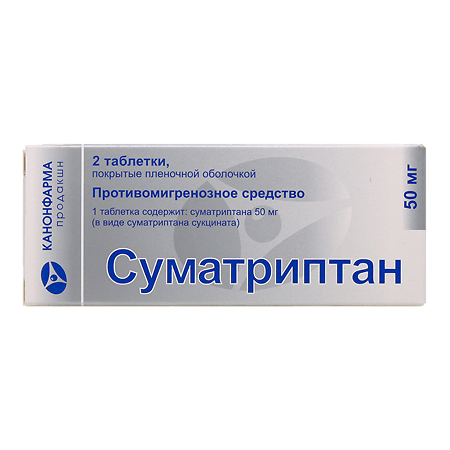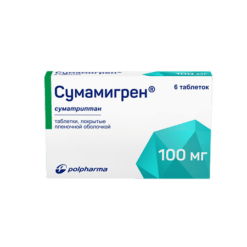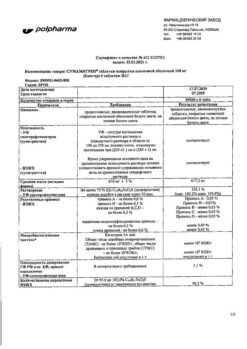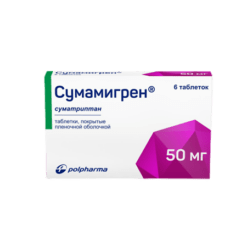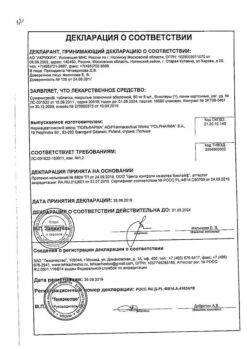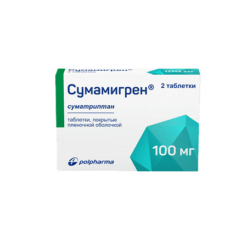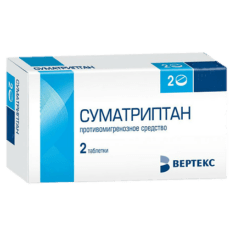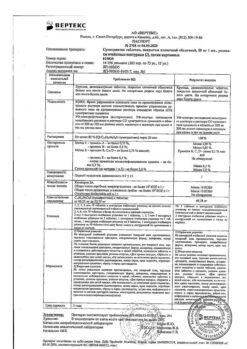No products in the cart.
Sumatriptan Canon, 50 mg 2 pcs
€3.21 €2.67
Out of stock
(E-mail when Stock is available)
Description
Antimigraine medication. Specific and selective agonist of 5-NT1-serotonin receptors, localized mainly in blood vessels of the brain, and does not act on other subtypes of 5-NT-serotonin receptors (5-NT2-7).
It causes narrowing of the carotid arterial bed vessels, which supply blood to the extracranial and intracranial tissues (dilation of the cerebral membrane vessels and/or their edema is the main mechanism of migraine development in humans), while not having a significant effect on cerebral blood flow.
Suppresses the activity of receptors of trigeminal nerve afferent fibers endings in the dura mater (as a result the release of sensory neuropeptides is reduced). It eliminates nausea and photophobia associated with migraine attack. In 50-70% of cases it quickly eliminates the attack when taken orally in a dose of 25-100 mg. Within 24 h, in 1/3 of cases a relapse may occur, requiring reapplication.
The onset of action is 30 minutes after an oral dose of 100 mg.
Pharmacokinetics
After oral administration it is rapidly absorbed, after 45 min its concentration in plasma reaches 70% of the maximum level. Bioavailability is 15% (due to presystemic metabolism and incomplete absorption). TCmax (after oral administration of 100 mg) is 2-2.5 h and is 51 mg/ml.
The binding to plasma proteins is 14-21%, total volume of distribution is 170 l (2.4 l/kg).
It is metabolized by oxidation with the help of monoamine oxidase (MAO) (mainly isoenzyme A) with formation of metabolites, basic of which are indole acetic analog of sumatriptan without pharmacological activity against 5-HT1- and 5-HT2-serotonin receptors and its glucuronide.
The T1/2 is 2-2.5 h. Plasma clearance is 1160 ml/min, renal clearance is 260 ml/min; extra-renal clearance is 40% after oral administration. Excreted by the kidneys, mainly as metabolites (97% after oral administration) – free acid or glucuronide conjugate.
Indications
Indications
Migraine (relief of attacks, with or without aura).
Pharmacological effect
Pharmacological effect
Antimigraine drug. A specific and selective agonist of 5-HT1-serotonin receptors, localized primarily in the blood vessels of the brain, and does not affect other subtypes of 5-HT-serotonin receptors (5-HT2–7).
Causes constriction of the vessels of the carotid arterial bed, which supply blood to extracranial and intracranial tissues (dilatation of the vessels of the meninges and/or their edema is the main mechanism for the development of migraine in humans), without having a significant effect on cerebral blood flow.
Suppresses the activity of the receptors of the endings of the afferent fibers of the trigeminal nerve in the dura mater (as a result, the release of sensory neuropeptides decreases). Eliminates nausea and photophobia associated with migraine attacks. In 50–70% of cases, it quickly eliminates an attack when taken orally at a dose of 25–100 mg. Within 24 hours, a relapse may develop in 1/3 of cases, requiring repeated use.
The onset of action is 30 minutes after oral administration at a dose of 100 mg.
Pharmacokinetics
After oral administration, it is quickly absorbed, after 45 minutes its plasma concentration reaches 70% of the maximum level. Bioavailability – 15% (due to first-pass metabolism and incomplete absorption). TCmax (after oral administration of 100 mg) is 2–2.5 hours and is 51 mg/ml.
Plasma protein binding is 14–21%, total volume of distribution is 170 l (2.4 l/kg).
Metabolized by oxidation with the participation of monoamine oxidase (MAO) (mainly isoenzyme A) with the formation of metabolites, the main of which are the indoleacetic analogue of sumatriptan, which does not have pharmacological activity against 5-HT1- and 5-HT2-serotonin receptors, and its glucuronide.
T1/2 – 2–2.5 hours. Plasma clearance – 1160 ml/min, renal clearance – 260 ml/min; extrarenal clearance – 40% after oral administration. It is excreted by the kidneys, mainly in the form of metabolites (97% after oral administration) – free acid or glucuronide conjugate.
Special instructions
Special instructions
Not intended for the prevention of migraine (administration during a migraine aura before the onset of other symptoms may not prevent the development of headache).
Patients at risk from the cardiovascular system do not begin therapy without preliminary examination (postmenopausal women, men over 40 years of age, persons with risk factors for coronary artery disease).
When prescribed during lactation, it is not recommended to breastfeed the child for 24 hours after taking sumatriptan.
In patients with hypersensitivity to sulfonamides, when administered sumatriptan, there is an increased risk of developing allergic reactions (from skin manifestations to anaphylactic shock).
If there is no effect on the first dose, the diagnosis should be clarified.
Experience with the use of sumatriptan in patients over 65 years of age is limited (no significant differences in pharmacokinetics are observed compared with younger patients).
Before prescribing sumatriptan to patients with newly diagnosed or atypical migraine, other potentially dangerous neurological diseases should be excluded.
It must be borne in mind that patients suffering from migraines are at risk of developing a stroke or transient cerebrovascular accident.
During the treatment period, care must be taken when driving vehicles and engaging in other potentially hazardous activities that require increased concentration and speed of psychomotor reactions.
Active ingredient
Active ingredient
Sumatriptan
Composition
Composition
Film-coated tablets, 50 mg and 100 mg. 2, 4, 6, 10 tablets in a blister pack made of polyvinyl chloride film and printed varnished aluminum foil.
1 blister pack along with instructions for use is placed in a cardboard pack.
1 film-coated tablet contains:
active substance
sumatriptan succinate 70 mg and 140 mg. in terms of sumatriptan 50 mg and 100 mg;
excipients:
hyprolose (hydroce and propyl cellulose Klucel LF, calcium hydrogen phosphate dihydrate, mannitol (mannitol).
magnesium stearate. croscarmellose sodium (primellose),
microcrystalline cellulose;
film shell composition: Selecout AQ-02003 [hypromellose (hydroxypropyl methylcellulose), macrogol (polyethylene glycol 6000). titanium dioxide].
Contraindications
Contraindications
Hypersensitivity, hemiplegic, basilar or ophthalmoplegic forms of migraine, coronary heart disease (CHD), (including suspicion of it), angina pectoris (including Prinzmetal’s angina), myocardial infarction (including history), arterial hypertension (uncontrolled), occlusive diseases of peripheral arteries, stroke or transient disorder cerebrovascular accident (including history), liver and/or kidney failure.
With caution
Epilepsy (including any conditions with a reduced epileptic threshold), arterial hypertension (controlled), pregnancy, lactation, childhood and adolescence (up to 18 years), old age (over 65 years); simultaneous use of drugs containing ergotamine and its derivatives, as well as MAO inhibitors and a period of up to 14 days after their discontinuation.
Side Effects
Side Effects
From the cardiovascular system: decrease in blood pressure (BP), transient increase in blood pressure (observed soon after administration), bradycardia. palpitations, tachycardia (including ventricular); in some cases – severe heart rhythm disturbances (up to ventricular fibrillation), transient ischemic ECG changes, myocardial infarction, and in isolated cases – Raynaud’s syndrome.
From the digestive system: nausea and vomiting; in some cases, a slight increase in the activity of “liver” transaminases. abdominal discomfort, dysphagia, ischemic colitis.
From the nervous system: dizziness, weakness (usually mild or moderate and transient); rarely – drowsiness, feeling tired (more often when taken orally); in some cases – epileptic seizures (usually with a history of epilepsy).
From the senses: sometimes – diplopia, flickering of spots before the eyes, nystagmus, scotoma, decreased visual acuity, very rarely – partial loss of vision (may be associated with the migraine attack itself).
Allergic reactions: skin rash (including urticaria and erythematous rashes), skin itching, anaphylactic reactions. Other: myalgia. “flushes” of blood to the face.
Interaction
Interaction
When administered simultaneously with ergotamine and ergotamine-containing drugs, prolonged vasospasm is possible (the interval between their administration should be at least 24 hours).
There may be an interaction between sumatriptan and MAO inhibitors (decreased metabolism of sumatriptan, increased its concentration).
With the simultaneous use of sumatriptan and drugs from the group of selective serotonin reuptake inhibitors, the development of weakness, hyperreflexia and impaired coordination of movements is possible.
Overdose
Overdose
Symptoms: when taken orally up to 400 mg, no other adverse reactions are observed other than those listed above.
Treatment: observation of the patient for 10 hours, symptomatic therapy.
Storage conditions
Storage conditions
Keep out of the reach of children. In a dry place, protected from light, at a temperature not exceeding 25°C.
Shelf life
Shelf life
2 years.
Manufacturer
Manufacturer
Kanonpharma production CJSC, Russia
Additional information
| Shelf life | 2 years. |
|---|---|
| Conditions of storage | Keep out of reach of children. Store in a dry place protected from light at a temperature not exceeding 25°C. |
| Manufacturer | Kanonfarma Production ZAO, Russia |
| Medication form | pills |
| Brand | Kanonfarma Production ZAO |
Other forms…
Related products
Buy Sumatriptan Canon, 50 mg 2 pcs with delivery to USA, UK, Europe and over 120 other countries.

